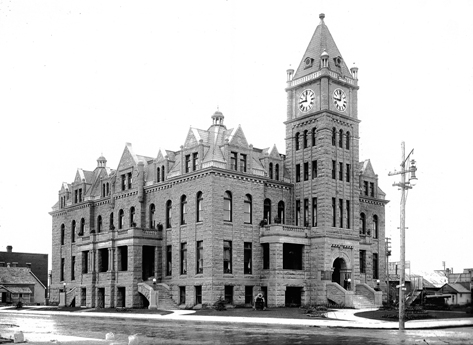Other Name(s)
Calgary City Hall National Historic Site of Canada
Calgary City Hall
Hôtel de ville de Calgary
Links and documents
n/a
Construction Date(s)
1907/01/01 to 1911/01/01
Listed on the Canadian Register:
2007/06/12
 Statement of Significance
Statement of Significance
Description of Historic Place
The 1911 Calgary City Hall, a four-storey sandstone building with central clock tower, is located on the corner of Macleod Trail and Seventh Avenue in downtown Calgary. Currently used as the office of the mayor and alderman, it is the architectural focal point of the City Hall complex that consists of two later additions - the 1962 four-storey brick extension to rear of the original building and the massive wedge-shaped, mirrored-glass structure that was built in 1985 and known as the Calgary Municipal Building. Its location on the eastern edge of the Central Business District, across from Olympic Plaza and near the terminus of Steven Avenue pedestrian Mall, forms the civic focal point of the city. The designation refers to the original 1907-1911 building.
Heritage Value
Calgary City Hall was designated a national historic site in 1984 because:
- it is the only surviving regional example of the monumental civic halls erected in several Prairie cities before 1930; and
- its lofty clock tower, prominent round-arched entry and extensive decoration in the Romanesque Revival style made it an imposing visual symbol of community progress.
Calgary City Hall is historically significant as an expression of the intensely optimistic mood of the pre-World War I economic boom. Officially opened in 1911, the City Hall was designed to address the growing city’s need for administrative space. Policing and related services were located on the ground floor of the building, while municipal services and city council occupied the remainder of the building. Its design and finish was a bold declaration of the city’s progress to date and its faith in its potential for future prosperity.
The Calgary City Hall was designed by architect William M. Dodd in the Romanesque Revival style. The locally-quarried sandstone walls, steeply-pitched tile roof, stone-gabled dormers, central clock tower, and semi-circular arched main entrance are features characteristic of this style and together they create an imposing structure that stands as an architectural symbol of the high aspirations of the young city.
Source: Historic Sites and Monuments Board of Canada, Minutes, Nov. 1984.
Character-Defining Elements
The key elements relating to the heritage value of this site include:
-elements illustrative of the Romanesque Revival style, including:
the rectangular massing with projecting bays capped with stone-gabled dormers,
the vertical expression of the square central clock tower capped with a tiled pyramidal roof,
the recessed main entrance in the central clock tower and the side entrances on the south and north facades,
the details of the main entrance including the semicircular sandstone arch supported by four red granite columns,
the steeply-pitched tiled roof accented with the stone dormers, decorative lanterns and the central glass dome,
the pattern of the fenestration and window style characterized by a mix of round and flat-headed windows on each elevation,
the decorative stone details such as dentils, string courses, ornamental surrounds along the cornice and on the windows,
the sandstone verandahs and balcony with stone balustrade covering and flanking each entrance, and,
the metal cornices;
-the rock faced sandstone walls with contrasting textures of the rusticated and smoothly dressed sandstone;
-elements contributing to the bold and optimistic symbol of civic confidence such as the exterior ironwork with a globe on each entrance rail, the elaborate design of the oak doors, the red granite cornerstone and the decorative sandstone keystone carved with the Calgary municipal crest and year “1907”;
- interior elements and finishes reflecting its formal municipal function including surviving evidence of the original interior plan, particularly in grand public spaces, the main entrance doors and vestibule, the main staircase with its wrought iron railings that extends up through three storeys and the associated stairwell space and light-well to the glass roof dome.
 Recognition
Recognition
Jurisdiction
Federal
Recognition Authority
Government of Canada
Recognition Statute
Historic Sites and Monuments Act
Recognition Type
National Historic Site of Canada
Recognition Date
1984/11/23
 Historical Information
Historical Information
Significant Date(s)
n/a
Theme - Category and Type
- Expressing Intellectual and Cultural Life
- Architecture and Design
- Governing Canada
- Government and Institutions
Function - Category and Type
Current
Historic
- Government
- Town or City Hall
Architect / Designer
William Dodd
Builder
n/a
 Additional Information
Additional Information
Location of Supporting Documentation
National Historic Sites Directorate, Documentation Centre, 5th Floor, Room 89, 25 Eddy Street, Gatineau, Quebec
Cross-Reference to Collection
Fed/Prov/Terr Identifier
12
Status
Published
Related Places

CITY HALL
Calgary's City Hall, built between 1907 and 1911, is a four-storey, sandstone-clad building designed in the Richardsonian Romanesque style. A centrally placed clock tower…